Mystery snails are not only peaceful and nonintrusive animals, but they are also attractively colorful creatures that will add some oomph to your aquarium while helping clean up the algae at the bottom.
These lovable creatures are an aquarist’s best friends, capable of serving their tasks throughout their one-year lifespan.
Caring for mystery snails is easy since most of what they eat is already in the tank, and once the initial conditions are set, you can leave them for weeks without much maintenance. Despite their ease of care, mystery snails suffer from several conditions and problems you will want to pay close attention to.
Read on to get a complete overview of the mystery snails and what they bring to an aquarist’s table. Learn about their temperament, many traits, and how to care for them effectively in an aquarium tank environment.
What are Mystery Snails?
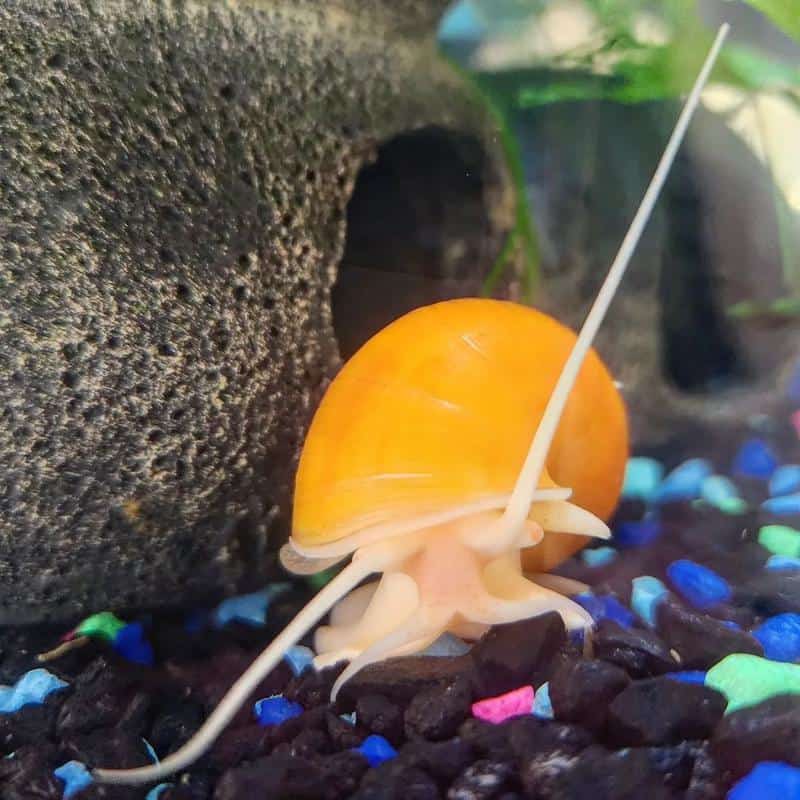
| Names | Mystery Snail (Pomacea bridgesii) |
| Origins and Reginal Distribution | Originally from Asia and South America
First found in Massachusetts in 1915 First consumed in California in 1892 when importation from native Asia began. |
| Water Hardness Conditions | 12 to 18 kH
8 to 18 gH |
| Lighting Conditions | Moderate with no direct bright sunlight |
| Average Size | 1 inch to 2.5 inches |
| Colors | Vary according to type featuring many colors and spots |
| Lifespan | 1 – 2 years |
| Food | Algae, dead leaves, and small leafy vegetation |
| Breeding | Freshwater conditions with 12 degrees of hardness |
| Optimal pH levels | 7.6 – 8.4 |
| Optimal Temperature | 68 – 84 degrees Fahrenheit |
Have you ever wondered why they are called mystery snails?
Mystery snails get their name from their quick reproduction. The mystery snails’ population can appear to get double overnight because the babies grow very fast, from hatchlings to fully formed juveniles in an instant.
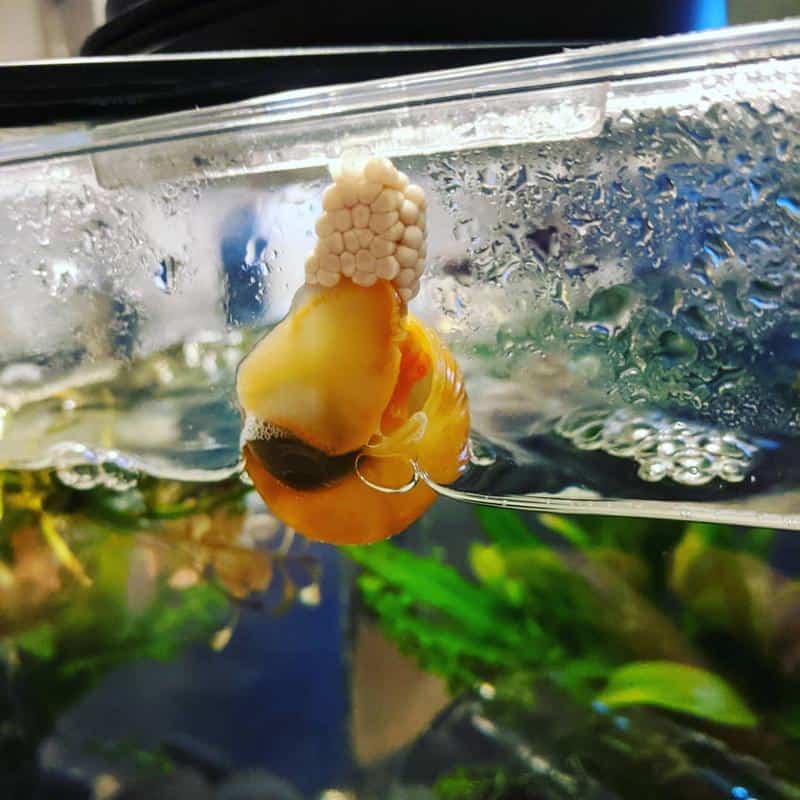
The female snail can lay eggs even after months without being next to a male snail for mating. The eggs are then laid on the surface of the water, where they take up to 4 weeks to hatch. The new borne then ‘mysteriously’ appear after a week in pea-sized bodies without much notice to the aquarists.
The name is also derived from the fact that mystery snails tend to disappear and appear in aquarium tanks. The solitary creatures often hide or spend days in hidden spots scavenging for food.
They will seem to have disappeared out of the tank, only for you to see them the next day on top of the water’s surface, catching some air.
With that said, where did the mystery snails come from?
Mystery Snail Origins
Mystery snails are native to Asia and some parts of South America, like Peru, Brazil, and Paraguay. The original habitants are known as the Chinese mystery snails, but several varieties have shown up since.
Mystery snails became popular among aquarists after being imported internationally in the 1800s (during the aquarium trade in the United States).
Their popularity is what led to their widespread because people soon started illegally disposing of them due to their huge numbers. They were often seen in lakes and rivers after being washed ashore in the nonnative environment.
In their natural habitats, you will often find mystery snails in lakes and rivers around tropical countries and environments. They do not survive in water temperatures that are below 50 degrees Fahrenheit (optimal temperatures are 68 – 84 degrees Fahrenheit).
The mystery snails have proven to be quite resilient, capable of surviving up to three years in the wild. However, the mystery snails have a shorter lifespan of fewer than two years in an aquarium environment.
Appearance: Colors and Size
One reason they can survive for so long is their ability to breathe in waters with low oxygen.
Mystery snails have gills for breathing underwater but also feature a lung and air tube that helps them get oxygen from the open air of the water’s surface. You will often see them breathing in open-air oxygen by swimming to the top of the aquarium water line and moving their bodies back and forth.
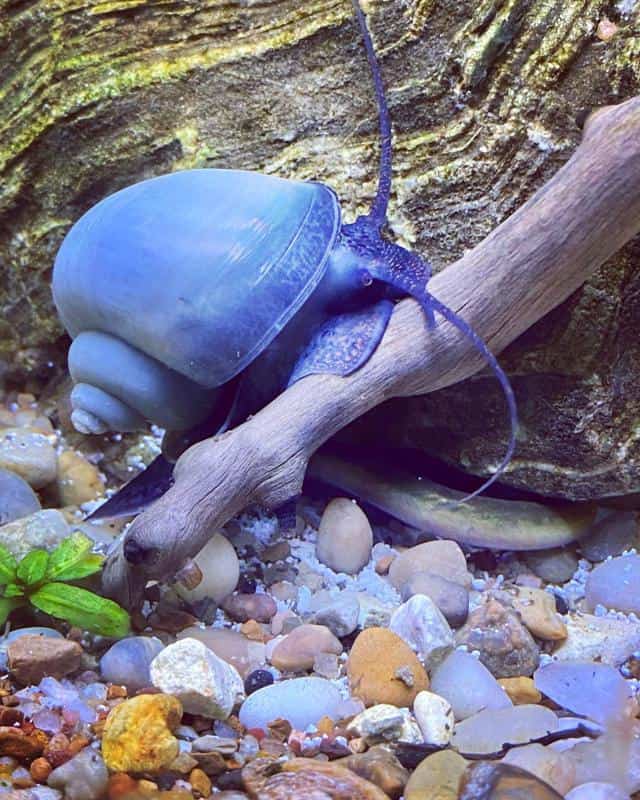
Mystery snails protect themselves with their shells but also their only sensory organ, their eyestalks connected to two tentacles. The eyestalks can grow over several weeks in case they get damaged, making them even more resilient.
Mystery snails come in various shapes and colors. They typically grow to about 2 inches, with most of the mystery snails being between 1 inch tall and 1.25 inches tall.
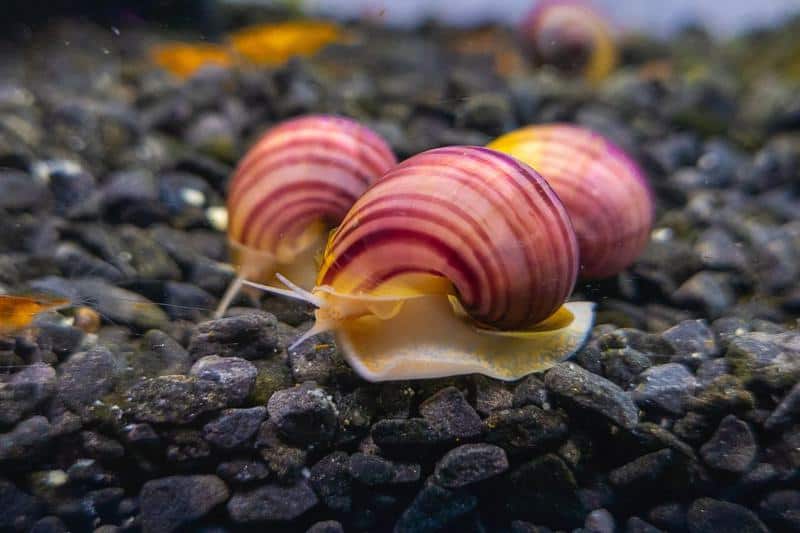
The Chinese mystery snail is characterized by a black shell, gills, and an operculum which is no different from its other descendants. The main difference between the mystery snails is their colors which range from golden to blue, purple, black, Ivory white, magenta, and Albino with brown striped shells.
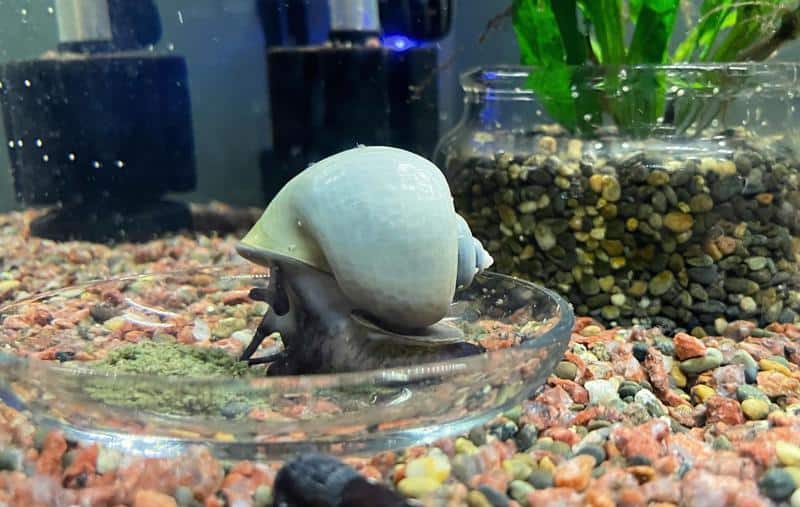
At the bottom of their shells is a huge muscle, their key mode of transportation, helping them drag their huge shells across the surface.
Speaking of shells, the operculum is placed right in front of the shells to act as the first defense line when attacked. The operculum is located on the opening of the shells making it harder for predators to reach the delicate insides of the mystery snails.
Breeding
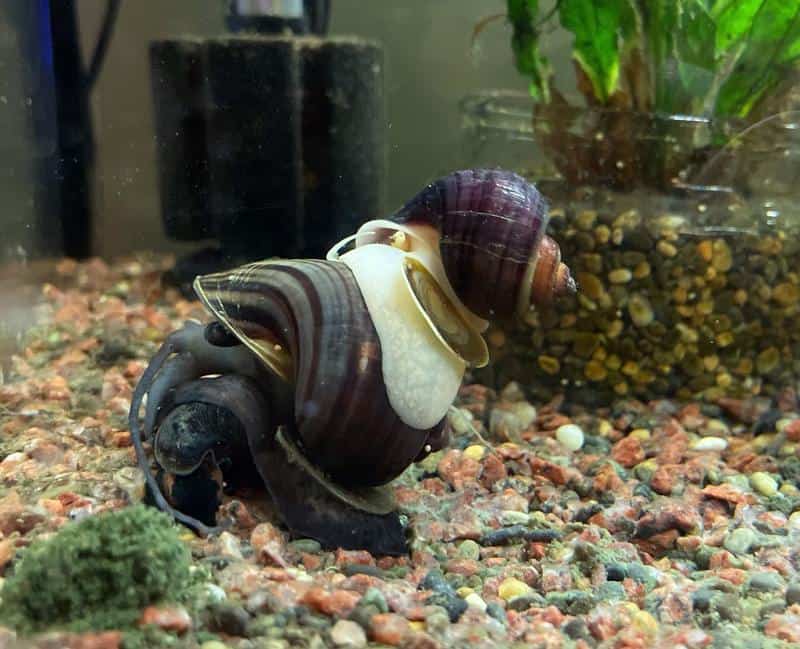
Breeding is one of those aspects that make you question if mystery snails are good for your tank. This is because some snails need special conditions to populate, while others can fill up your tank with dozens of their babies in just a week.
When picking up relentless algae-eating snails for your tank, it is important to note how the snails breed so as to prevent a pest infestation and make it easier for you to get more snails for other aquarium tanks.
Breeding for mystery snails is straightforward and needs little to no care. No tweaking on the tank or water conditions is required to make it conducive for breeding. This is why mystery snails are more convenient for breeding than Nerite snails, which require saltwater with a hardness level of 12 kH.
Mystery Snails produce sexually; you will need to have two sexes, a male and a female, both of which you can get at the pet store for less than $11 per 3 snails. The two sexes mate in a process called mounting, after which the female lays the eggs on top of the water’s surface. After 2-4 weeks, the eggs hatch, and one week later, you have pea-sized young mystery snails.
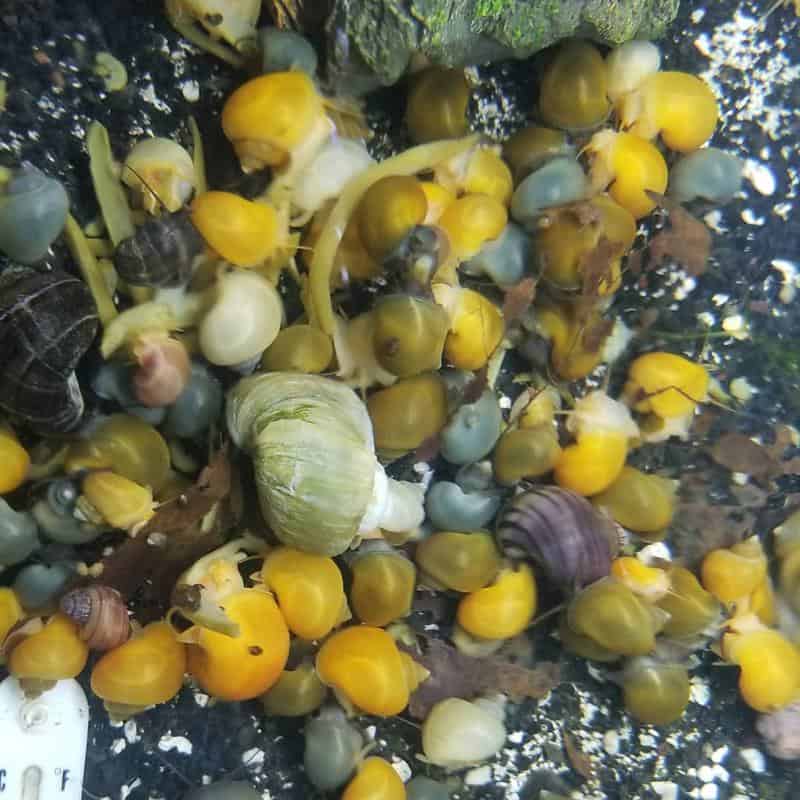
Follow these steps to successfully breed the mystery snails:
- Feed the snails high-nutrient foods to ensure the babies are healthy and can live longer. Ensure the diet is rich in calcium from natural sources like cabbage and kale, or use calcium supplements.
- Reduce the waterline height to about 3-4 inches so that there is some egg-laying space at the top of the water surface.
- Proceed to ensure that the water temperature is between 73- and 74 degrees Fahrenheit for optimal breeding conditions.
- Watch out for the male mystery snail who will mount the female snail for up to 4 hours every day. Some male snails can overdo the mating process, which stresses the females and reduce the effectiveness of the process. These male snails should be put in separate tanks from time to time to take a break from their female mates.
- The female snails will then lay the eggs on the water surface in clutches/cocoons that will be clearly visible. Some females may hide the eggs under filters or the lid to protect them.
- If the tank has some predatory fish that may eat snail eggs or hatchlings, then it is time to transfer the eggs to a separate tank. However, it is ideal to leave the eggs where they are for the 2-4 weeks it takes them to hatch.
- Watch the magic happen after the few weeks when the eggs hatch and bring forth young hatchlings that turn into snail juveniles in about a week. Remember to be mindful of the tank size since snails can lay up to 300 eggs in one clutch.
Temperament
Mystery snails have a solitary and peaceful temperament that makes them a breeze to take care of. You would think that this would make them an easy target for snail-eating animals, but this is rarely the case because of their 2-inch-sized shells. They are easily hunted down in the wild but won’t find many biters in your standard fish tank unless you so choose to pair them with aggressive snail-eating fish.
Mystery snails have no attacking mechanism but have a defense mechanism (using their shell and operculum). This makes them prey to bigger aquarium snail-eating fish and a bit more helpless in the wild, where they can get attacked by anything.
The snails are very active when lights are on, eating lots of food, waste, and algae as they move about the aquarium. They also feed in the darkness. At night, they get to the surface, moving back and forth with their siphons outside the water to take in the air.
They love going up to the top of the surface and letting go as they fall down to the depths of the aquarium. Sometimes they free-fall down slowly and sometimes slide along the glass, slowly eating more food on their way down.
Mystery Snail Care
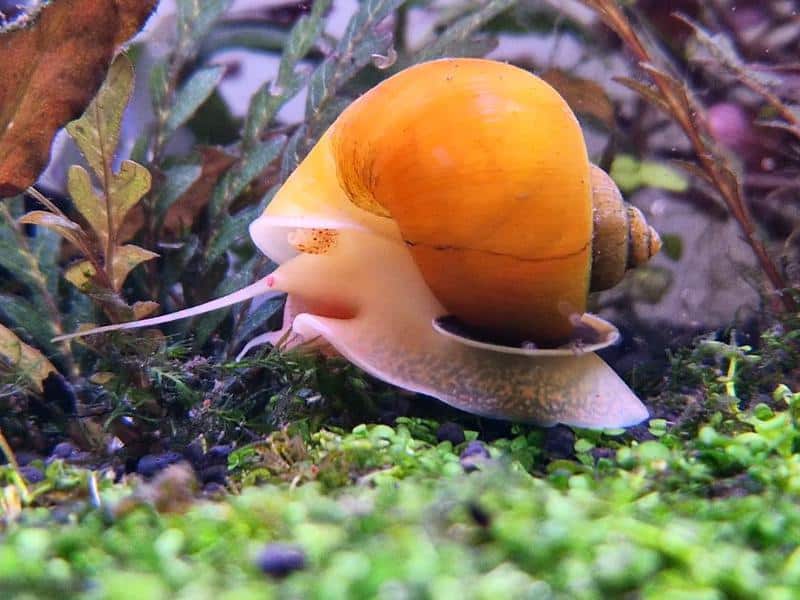
Are mystery snails hard to keep alive?
Mystery Snails are easy to care for. They do not need much in terms of food, they are active algae eaters, which means waste management will rarely be a problem, and they are relentlessly tough, capable of surviving a few spikes in water parameters.
However, some conditions can be fatal to the life of a mystery snail. Copper is a huge killer for invertebrates like the mystery snails, and calcium deficiency is the number one cause of the snail’s shells cracking. Keep an eye on these two conditions, and your mystery snails will live long and healthy lives.
Follow our other standard recommendations for a more thorough approach to caring for your mystery snails.
Mystery Snail Tank Size & Environment
The recommended tank size for caring for one mystery snail is five gallons. Some hobbyists believe adding a few mystery snails together in tight spaces is okay because of their temperament, but they are wrong. An extra five gallons per snail is the recommended strategy for bigger tanks and any future upgrades.
Space for snails is as important as it is for other aquatic animals. Tank size also affects the amount of bio-waste in the tank. The small tank size will suffer more as the snails’ waste adds more weight to the entire system.
You also have to consider the size of the entire environment: the number of fishes, the size of the plants & algae, and the types of fish in the tank.
Do not place mystery snails in a tank of snail-eating fish. The snails can get along with most freshwater fish unless the species feeds on mystery snails (or other snails, for that matter) in the wild.
Great recommendations include tetras, red cherry shrimp, ghost shrimp, Cory Catfish, Betta fish, and Killifish.
Plants fit for a mystery snail tank range from Java moss to the Anubias barteri and hornwort. Hardy plants are the best choices since they will survive more when they start getting nibbled upon by the mystery snails. Pick and choose from a wide variety to see which fits your environment.
Consider putting a lid or other covering structure on top of your tank.
Snails are good at getting out of the tank. They often climb up to the top of the water surface, scavenging for food, and can easily crawl to the top of the tank and fall out. This runs the risk of you losing your snails when they dry out or getting injured during the fall.
Their shells may crack, leading to irreversible damage, or they may experience other physical trauma that will leave them inactive. Keeping the top covered ensures your little creatures stay healthy and sound. It will also help if you leave a lengthy clearance between the water surface and the top of the tank to deter them further from moving up.
So, when should you introduce Mystery snails into the tank?
It is advisable to only introduce mystery snails in the aquarium when you have enough naturally present, medium-level algae that the snails can feed on.
Mystery snails only clean the aquarium by feeding on naturally growing algae. These snails will be little help in case your algae problem is caused by a bigger issue like extra uneaten fish food, excessive lighting, or high nutrient buildup. In such cases, you will need to get to the root cause of the problem before introducing the mystery snails.
Water Quality and Water Parameters
As stated earlier, the mystery snails are a resilient bunch. They can survive various water conditions, but they are not foolproof.
Mystery snails are sensitive to sudden changes in water temperatures. Stability is more important than perfect temperatures, between 68- and 84 degrees Fahrenheit. Snails also prefer water on the hard side, while moderate tank lighting is more than enough for them.
Like other aquarium animals, you should always ensure the ammonia, nitrate, and nitrite levels are at 0 ppm. Moreover, you should always ensure sufficient calcium in the water to keep the shells from cracking or getting thin.
As a summary, keep the Mystery Snail water parameters at the following levels:
- Water Hardness: 12- 15 kH
- Water Temperature: 68 – 84-degree Fahrenheit
- pH levels: 6 – 8.4
Another water condition that is easy to forget is copper contamination. Many first-timers use untreated tap water in their aquariums. Such water is of poor quality and can contain copper, which is lethal to invertebrates like mystery snails.
Copper can also get into the water through fish food, medication (copper sulfate), or live plant fertilizers. Ensure you check the ingredients of any food or chemical getting into the water containing mystery snails (or any aquatic life in general).
Diet
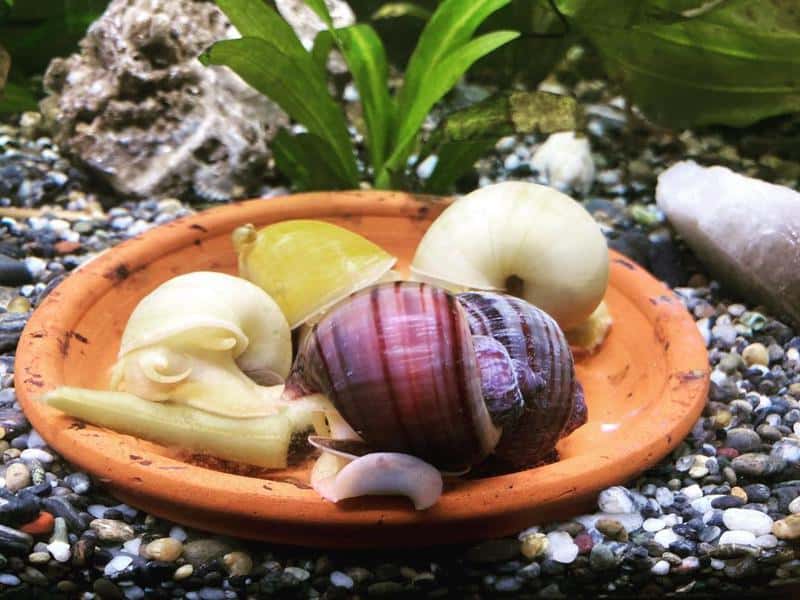
Do not worry about what to feed mystery snails. As long as your tank is in normal working conditions, algae will naturally grow at the bottom, which will serve as the snails’ food.
You can promote algae growth by adding rockier substrate like gravel to ensure the mystery snails never run out of their favorite food.
Plants like the Java moss and hornworts are a great addition to a tank containing mystery snails. These plants act as supplementary foods that the snails can nibble on when moving up and down.
You may be asking, will the mystery snails eat my live plants? And the answer is no. Mystery Snails are only scavengers who prefer dead decaying plants over live plants. If you see them nibbling on the live plant leaf, then this is a good sign that tells you the leaf is dying.
Snails can sense dying material, and they will feed on it to save you the hassle of getting rid of the material yourself. Mystery snails will also ravage any dead vegetation on most parts of the tank, from the glass surface to the filters.
Small leafy vegetables like zucchini slices, lettuce, and kale are good foods you can drop into the aquarium when snails lack other food sources.
Additionally, these vegetables are great sources of calcium which helps strengthen the shells of the mystery snails. Calcium prevents the snails’ shells from breaking or peeling.
In the unfortunate event that your mystery snails start losing their shell strength, then it is advisable you opt for calcium supplements found in food additives. A good example is the Zoo Med Nano Banquet Food Blocks.
Precautions to Take when Buying Mystery Snails
The first thing you should look into when caring for mystery snails is to ensure you get healthy ones.
It can be challenging taking care of unhealthy mystery snails, which is why getting one that is fully healthy and ready to kick it for many months is vital. Start by avoiding any purchase from a stock that seems sickly or older. Older and sickly snails may have calcium deficiency, weaker immune systems, and other common snail infections.
It is also a good practice to pick snails without deformities like irregular shells or irregular shell growth. Do not buy snails with cracked or pitted shells since they are unhealthy or have been affected by acidic waters, which dissolve the shell.
You should also avoid still snails; they may be sick, hence less active.
Read More:
- Bladder Snail Guide: Size, Lifespan, Care, Diet & More
- Assassin Snail Care Guide
- Is My Aquarium Snail Dead?
Final Thoughts
It is hard not to fall in love with the mystery snails. They are very attractive with their beautiful range of colors and are peaceful creatures that make it easy to care for them.
We highly recommend them for active algae-cleaning maintenance as well as breeding purposes.